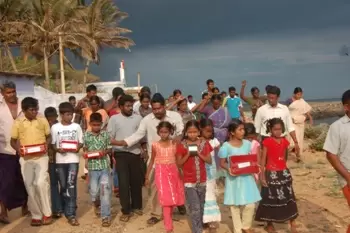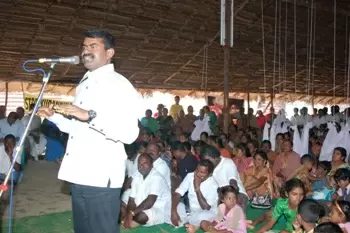It is only a fruition of 25 years of sustained social activism

03-November-2011
Vol 2 | Issue 44
The ongoing people’s agitation to protest against the Koodankulam Nuclear Power Project (KKNPP) in the coastal village of Idinthakarai in Tirunelveli might have been triggered by a bout of panic after the Fukushima disaster, but anti-nuclear activists in Tamil Nadu see in it the fruition of their sustained campaign in various forms since a quarter century.
 |
|
Children taking part in an anti-nuclear power plant protest in Koodankulam
|
While the present agitation has thrown up a major challenge to the Union government and the nuclear establishment mainly because it is being staged by the people living in the backyard of the nuclear reactors, the awareness on the hazards of nuclear plants among the people was not created overnight, say some activists, who had started raising their voice against the project way back in 1987 even when the project was in the conceptual stage.
Though some of those activists are still directly involved in the fight against the commissioning of the reactors in Koodankulam, many of them have moved out to give moral support from the sidelines.
Anton Gomez, leader of the Tamil Nadu Fishermen Association, from Thoothukudi, who was one of the pioneers in organising a campaign initially, is still around and was part of the team that called on PM Manmohan Singh recently.
T S S Mani, a former Naxalite and media personality, who was with Gomez right from the beginning, recalled that it was an article in the Indian Express, detailing possible repercussions of having a nuclear plant in the district, that stirred the consciousness of activists.
Prominent among those who were part of the Koodankulam Anti-nuke Confederation, the organisation that sought to stir the consciousness of the people all over Tamil Nadu and also in places such as Mumbai and Delhi after its launch in 1988 were: Gomez, Mani, an engineer-turned journalist G Ramesh, Fr Samy of Indian Catholic Youth Federation and Dr C N Deivanayagam of Chennai.
Deivanayagam’s house was then the meeting place for the activists for the doctor had documented an increase in cancer cases in Kalpakkam and the material was used for the campaign in the initial stages.
The first campaign, however, was in Idinthakarai in September, 1987, with many speakers from Chennai, including journalists like Ramesh, addressing the crowd, said Mani.
In that phase of the campaign, the stress was more on ‘anti-war’ with the activists highlighting that nuclear reactors are set up to build nuclear weapons.
In 1988, a cycle rally by about 150 people was taken up by the Indian People’s Front (IPF) from Thoothukudi to Tirunelveli through Nagercoil and Koodankulam when the tail end of the procession came under attack at Koodankulam.
Mani said that a counter campaign was launched by the CPM and the Congress then — CPM because the project involved the erstwhile Soviet Union and the Congress because then PM Rajiv Gandhi was the one who envisaged it.
The same year, a rally and public meeting was also held in Tirunelveli by the confederation, in which Rev Y David, a Protestant pastor-turned social activist, who then ran an organisation called Samathuva Samudhya Iyakkam and working for the welfare of Palmyra workers, brought in his people.
Former Union minister George Fernandes was the main speaker in a meeting held in Thoothukudi in 1989 when Balaprajathipathi Adigalar, the head of the Ayavazhi cult, took an active part. Some local BJP leaders also addressed the crowd and even the Dravidar Kazhagam’s representative was on stage, said Mani.
Those days, newspapers and magazines in Tamil Nadu actively carried features and stories on the campaign and also ran articles written by people like Ramesh, whose series was titled Kollavarum Koodankulam (Death threat from Koodankulam).
When the then DMK MP, Vaiko, said in Parliament that “humanity will be wiped out if the plant comes,” some papers even carried it as the lead story, Mani recalled.
Subsequently, when then USSR president Mikhail Gorbachev visited India, two black flag protests were attempted in Delhi and Mumbai by the confederation.
When a national fishermen’s rally, led by Fr Thomas Kocheri, visited Kanyakumari in 1989 under the title ‘Save water, save life’, slogans were raised against Koodankulam and there was even a police firing. In Mumbai, a protest was held in 1989 at Kala Goda under the banner of Indian Federation of Trade Unions (ML group).
 |
|
Actor politician Seeman addressing the protestors in Koodankulam
|
IPF organised rallies and protests in Chennai. Fr Samy organised a ‘Scientific Conference’ in Madurai and prepared 100 students to campaign in non-fishing villages around Koodankulam.
Meanwhile, when there were plans to supply water to the plant from Pechiparai dam in Kanyakumari, a local politician Dr Kumaradoss organised a series of protests by mobilising the farmers.
Between May 3 and 13, 1989, several street corner meetings were held in non-fishing villages and on the final day a meeting was organised in Koodankulam. Police initially refused permission for the meeting citing law and order problems but finally relented by allowing it in a school ground.
Mani recalled that the police officer told them that it was the same ground from where Rajiv Gandhi was to have addressed the crowd when he was expected to visit Koodankulam to lay the foundation stone for the project. But police barricaded the area preventing many people from entering the ground, Mani said.
Rajiv Gandhi never came mainly because of the protests. Even other dignitaries like former President R Venkatraman and former chief minister M Karunanidhi were expected for the inauguration, said Mani.
Then the project itself went into limbo with the disintegration of the USSR and the campaign lost steam.
Again when the project was revived under an Indo-Russian agreement, the campaign gained strength and many meetings were held. Apart from that, activists distributed pamphlets and booklets against nuclear energy.
One of the booklets by Y David, Koodankulam Anumin Nilayam — Vendave Vendam (Koodankulam nuclear plant — No, No), which was first brought out in 1988, was very popular among the people that it ran into four print, runs subsequently with updates. The fourth run was in 1997.
The present leader of the movement, S P Udayakumar, returned from the US in 2001 when David was leading the campaign with Balaprajathipathi Adigalar taking an active role. As David said, he found in Udayakumar an effective leader and handed over the mantle.
Udayakumar said he had been holding street corner meetings and distributing pamphlets for the last several years. He had even brought Medha Patkar to Koodankulam to address meetings.
He said he is still mobilising support. On a hot Saturday when the people of Idinthakarai were on fast, he along with others were at work. They went to nearby Thesayanvillai to mobilise support.
Published by special arrangement with The New Indian Express














